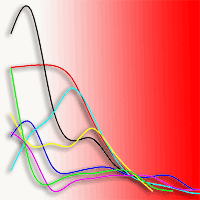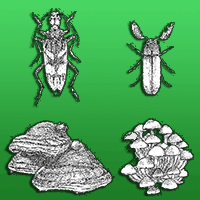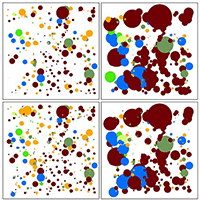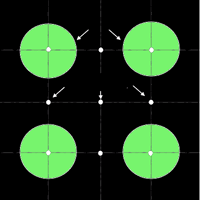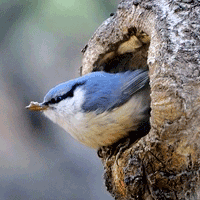In recent decades, the conservation of biodiversity has become one of the main areas under consideration in managing forests in an ecologically sustainable way. Forest management practices are primary drivers of diversity and may enhance or decrease forest biodiversity, according to the measures applied (thinning options). We have focused on three beech (Fagus sylvatica L.) forests across a latitudinal gradient in Italy, characterised by different structures resulting from dissimilar management. We tested the short-term effects of differently-based silvicultural intervention vs. stands where no silvicultural practices were applied on biodiversity indicators and related proxies: deadwood amounts, microhabitat density, floristic richness and life form abundance. In each study area, the occurrence of the above indicators and proxies was evaluated before and after the implementation of crop tree thinning (CTT) and thinning from below (LT) methods, comparing them with control areas where no interventions were performed. After two years, the management options resulted in different responses of the investigated parameters. The CTT increased deadwood amounts in comparison with the LT ones, while stumps increased significantly after the LT thinning. Microhabitats increased significantly where intervention was not undertaken. On the contrary, they remained unaltered after the LT treatments. CTT thinning created favourable conditions for the development of microhabitats and their proliferation in the long term. Two years after the application of the CTT thinning treatment, all forest stands demonstrated a significant increase in their floristic richness and herb layer cover. Significant differences were also found in both the frequency and cover of life forms in relation to silvicultural treatment. These findings provide a better understanding of short-term effects of silvicultural treatment useful for maintaining biodiversity in mountain beech forests.
Keywords
, , , , ,
Citation
Lombardi F, Lella SD, Altieri V, Benedetto SD, Giancola C, Lasserre B, Kutnar L, Tognetti R, Marchetti M (2018). Early responses of biodiversity indicators to various thinning treatments in mountain beech forests. iForest 11: 609-618. - doi: 10.3832/ifor2733-011
Academic Editor
Agostino Ferrara
Paper history
Received: Jan 19, 2018
Accepted: Jun 26, 2018
First online: Sep 25, 2018
Publication Date: Oct 31, 2018
Publication Time: 3.03 months
© SISEF - The Italian Society of Silviculture and Forest Ecology 2018
Open Access
This article is distributed under the terms of the Creative Commons Attribution-Non Commercial 4.0 International (https://creativecommons.org/licenses/by-nc/4.0/), which permits unrestricted use, distribution, and reproduction in any medium, provided you give appropriate credit to the original author(s) and the source, provide a link to the Creative Commons license, and indicate if changes were made.

Breakdown by View Type
(Waiting for server response...)
Article Usage
Total Article Views: 47555
(from publication date up to now)
Breakdown by View Type
HTML Page Views: 39544
Abstract Page Views: 3599
PDF Downloads: 3419
Citation/Reference Downloads: 8
XML Downloads: 985
Web Metrics
Days since publication: 2656
Overall contacts: 47555
Avg. contacts per week: 125.33
Article Citations
Article citations are based on data periodically collected from the Clarivate Web of Science web site
(last update: Mar 2025)
Total number of cites (since 2018): 12
Average cites per year: 1.50
Publication Metrics
by Dimensions ©
Articles citing this article
List of the papers citing this article based on CrossRef Cited-by.
(1)
Alberti G, Boscutti F, Pirotti F, Bertacco C, De Simon G, Sigura M, Bonfanti P (2013)A LiDAR-based approach for a multi-purpose characterization of Alpine forests: an Italian case study. iForest 6: 156-168.
CrossRef |
Gscholar
(2)
Becagli C, Puletti N, Chiavetta U, Cantiani P, Salvati L, Fabbio G (2013)Early impact of alternative thinning approaches on structure diversity and complexity at stand level in two beech forests in Italy. Annals of Silvicultural Research 37: 55-63.
Online |
Gscholar
(3)
Biswas SR, Mallik AU (2010)Disturbance effects on species diversity and functional diversity in riparian and upland plant communities. Ecology 91: 28-35.
CrossRef |
Gscholar
(4)
Burrascano S, Lombardi F, Marchetti M (2008)Old-growth forest structure and deadwood: Are they indicators of plant species composition? A case study from central Italy. Plant Biosystems 142: 313-323.
CrossRef |
Gscholar
(5)
Dearden FM, Wardle DA (2008)The potential for forest canopy litterfall interception by a dense fern understorey, and the consequences for litter decomposition. Oikos 117: 83-92.
CrossRef |
Gscholar
(6)
Di Salvatore U, Tonti D, Chiavetta U, Cantiani P, Fabbio G, Becagli C, Bertini G, Sansone D, Skudnik M, Kobal M, Kutnar L, Ferreira A, Kobler A, Kovač M, Ferretti F (2016)ManFor CBD sites and the drivers of forest functions. Italian Journal of Agronomy 11 (S1): 64-95.
Gscholar
(7)
Fahey RT, Puettmann KJ (2007)Ground-layer disturbance and initial conditions influence gap partitioning of understorey vegetation. Journal of Ecology 95: 1098-1109.
CrossRef |
Gscholar
(8)
Gamborg C, Larsen JB (2003)“Back to nature” - a sustainable future for forestry? Forest Ecology and Management 179: 559-571.
CrossRef |
Gscholar
(9)
Gendron F, Messier C, Comeau PG (1998)Comparison of various methods for estimating the mean growing season percent photosynthetic photon flux density in forests. Agricoltural Forest and Meteorology 92: 55-70.
CrossRef |
Gscholar
(10)
Graae BJ, Sunde PB (2000)The impact of forest continuity and management on forest floor vegetation evaluated by species traits. Ecography 23: 720-731.
CrossRef |
Gscholar
(11)
Guby NB, Dobbertin M (1996)Quantitative estimates of coarse woody debris and standing dead trees in selected Swiss forests. Global Ecology and Biogeography Letters 5: 327-341.
CrossRef |
Gscholar
(12)
Haila Y (1994)Preserving ecological diversity in boreal forests: ecological background, research, and management. Annales Zoologici Fennici 31: 203-217.
Online |
Gscholar
(13)
Harmon ME, Franklin JF, Swanson FJ, Sollins P, Gregory SV, Lattin JD, Lienkaemper GW (1986)Ecology of coarse woody debris in temperate ecosystems. Advances in Ecological Research 15: 133-302.
CrossRef |
Gscholar
(14)
Herbeck LA, Larsen DR (1999)Plethodontid salamander response to silvicultural practices in Missouri Ozark forests. Conservation Biology 13: 623-632.
CrossRef |
Gscholar
(15)
Hodgson JG, Grime JP, Wilson PJ, Thompson K, Band SR (2005)The impacts of agricultural change (1963-2003) on the grassland flora of Central England: processes and prospects. Basic and Applied Ecology 6: 107-118.
CrossRef |
Gscholar
(16)
Humphrey JW, Davey S, Peace AJ, Ferris R, Harding K (2002)Lichens and bryophyte communities of planted and semi-natural forests in Britain: the influence of site type, stand structure and deadwood. Biological Conservation 107: 165-180.
CrossRef |
Gscholar
(17)
Kern CC, Montgomery RA, Reich PB, Strong TF (2014)Harvest-created canopy gaps increase species and functional trait diversity of the forest ground-layer community. Forest Science 60: 335-344.
CrossRef |
Gscholar
(18)
Kerr G (1999)The use of silvicultural systems to enhance the biological diversity of plantation forests in Britain. Forestry 72: 191-205.
CrossRef |
Gscholar
(19)
Khanina L, Bobrovsky M, Komarov A, Mikhajlov A (2007)Modeling dynamics of forest ground vegetation diversity under different forest management regimes. Forest Ecology and Management 248: 80-94.
CrossRef |
Gscholar
(20)
Knapp EE, Skinner CN, North MP, Estes BL (2013)Long-term overstory and understory change following logging and fire exclusion in a Sierra Nevada mixed-conifer forest. Forest Ecology and Management 310: 903-914.
CrossRef |
Gscholar
(21)
Kutnar L, Eler K, Marinšek A (2015)Effects of different silvicultural measures on plant diversity - the case of the Illyrian
Fagus sylvatica habitat type (Natura 2000). iForest 9: 318-324.
CrossRef |
Gscholar
(22)
Larrieu L, Cabanettes A (2012)Species, live status, and diameter are important tree features for diversity and abundance of tree microhabitats in subnatural montane beech-fir forests. Canadian Journal of Forest Research 42: 1433-1445.
CrossRef |
Gscholar
(23)
Larrieu L, Cabanettes A, Gouix N, Burnel L, Bouget C, Deconchat M (2017)Development over time of the tree-related microhabitat profile: the case of lowland beech-oak coppice-with-standards set-aside stands in France. European Journal of Forest Research 136: 37-49.
CrossRef |
Gscholar
(24)
Lindenmayer DB, Margules CR, Botkin DB (2000)Indicators of biodiversity for ecologically sustainable forest management. Conservation Biology 14: 941-950.
CrossRef |
Gscholar
(25)
Lombardi F, Cherubini P, Tognetti R, Marchetti M (2008a)Tree rings assess deadwood decay rates in beech and silver fir forests in Central Apennines (Molise, Italy). Canadian Journal of Forest Research 38: 821-833.
CrossRef |
Gscholar
(26)
Lombardi F, Lasserre B, Tognetti R, Marchetti M (2008b)Deadwood in relation to stand management and forest type in Central Apennines (Molise, Italy). Ecosystems 11: 882-894.
CrossRef |
Gscholar
(27)
Lombardi F, Lasserre B, Chirici G, Tognetti R, Marchetti M (2012)Deadwood occurrence and forest structure as indicators of old-growth forest conditions in Mediterranean mountainous ecosystems. Ecoscience 19: 344-355.
CrossRef |
Gscholar
(28)
Lombardi F, Marchetti M, Corona P, Merlini P, Chirici G, Tognetti R, Burrascano S, Alivernini A, Puletti N (2015)Quantifying the effect of sampling plot size on the estimation of structural indicators in old-growth forest stands. Forest Ecology and Management 346: 89-97.
CrossRef |
Gscholar
(29)
MacDicken KG, Sola P, Hall JE, Sabogal C, Tadoum M, De Wasseige C (2015)Global progress toward sustainable forest management. Forest Ecology and Management 352: 47-56.
CrossRef |
Gscholar
(30)
Michel AK, Winter S (2009)Tree microhabitat structures as indicators of biodiversity in Douglas-fir forests of different stand ages and management histories in the Pacific Northwest, USA. Forest Ecology and Management 257: 1453-1464.
CrossRef |
Gscholar
(31)
Mikusinski G, Angelstam P (1997)European woodpeckers and anthropogenic habitat change: a review. Vogelwelt 118: 277-283.
Online |
Gscholar
(32)
Morrissey RC, Jenkins MA, Saunders MR (2014)Accumulation and connectivity of coarse woody debris in partial harvest and unmanaged relict forests. PLoS ONE 9: e113323.
CrossRef |
Gscholar
(33)
Nilsson MC, Wardle DA (2005)Understory vegetation as a forest ecosystem driver: evidence from the northern Swedish boreal forest. Frontiers in Ecology and the Environment 3: 421-428.
CrossRef |
Gscholar
(34)
Odor P, Standovár T (2001)Richness of bryophyte vegetation in near-natural and managed beech stands: the effects of management-induced differences in dead wood. Ecological Bulletins 49: 219-229.
Online |
Gscholar
(35)
Paillet Y, Bergès L, Hjältén J, Odor P, Avon C, Bernhardt-Römermann M, Kanka R (2010)Biodiversity differences between managed and unmanaged forests: meta-analysis of species richness in Europe. Conservation Biology 24: 101-112.
CrossRef |
Gscholar
(36)
Paillet Y, Pernot C, Boulanger V, Debaive N, Fuhr M, Gilg O, Gosselin F (2015)Quantifying the recovery of old-growth attributes in forest reserves: A first reference for France. Forest Ecology and Management 346: 51-64.
CrossRef |
Gscholar
(37)
Pecl GT, Araújo MB, Bell JD, Blanchard J, Bonebrake TC, Chen IC, Clark TD, Colwell RK, Danielsen F, Evengård B, Falconi L, Ferrier S, Frusher S, Garcia RA, Griffis RB, Hobday AJ, Janion-Scheepers C, Jarzyna MA, Jennings S, Lenoir J, Linnetved HI, Martin VY, McCormack PC, McDonald J, Mitchell NJ, Mustonen T, Pandolfi JM, Pettorelli N, Popova E, Robinson SA, Scheffers BR, Shaw JD, Sorte CJB, Strugnell JM, Sunday JM, Tuanmu MN, Vergés A, Villanueve C, Wernberg T, Wapstra E, Williams SE (2017)Biodiversity redistribution under climate change: impacts on ecosystems and human well-being. Science 355 (6332): eaai9214.
CrossRef |
Gscholar
(38)
Pedlar JH, Pearce JL, Venier LA, McKenney DW (2002)Coarse woody debris in relation to disturbance and forest type in boreal Canada. Forest Ecology and Management 158: 189-194.
CrossRef |
Gscholar
(39)
Pignatti S (1982)Flora d’Italia (3 vol) [Italian Floristic Atlas (Vol. 3)]. Ed. Agricole, Bologna, Italy, pp. 595. [in Italian]
Gscholar
(40)
Remm J, Lohmus A, Remm K (2006)Tree cavities in riverine forests: what determines their occurrence and use by hole-nesting passerines? Forest Ecology and Management 221: 267-277.
CrossRef |
Gscholar
(41)
Rouvinen S, Kuuluvainen T (2001)Amount and spatial distribution of standing and downed dead trees in two areas of different fire history in a boreal Scots pine forest. Ecological Bulletins 49: 115-127.
Online |
Gscholar
(42)
Siitonen J (2001)Forest management, coarse woody debris and saproxylic organisms: Fennoscandian boreal forests as an example. Ecological Bulletins 49: 11-41.
Online |
Gscholar
(43)
Tabacchi G, Di Cosmo L, Gasparini P (2011)Aboveground tree volume and phytomass prediction equations for forest species in Italy. European Journal of Forest Research 130: 911-934.
CrossRef |
Gscholar
(44)
Thom D, Seidl R (2016)Natural disturbance impacts on ecosystem services and biodiversity in temperate and boreal forests. Biological Reviews 91: 760-781.
CrossRef |
Gscholar
(45)
Vuidot A, Paillet Y, Archaux F, Gosselin F (2011)Influence of tree characteristics and forest management on tree microhabitats. Biological Conservation 144: 441-450.
CrossRef |
Gscholar
(46)
Winter S, Möller GC (2008)Microhabitats in lowland beech forests as monitoring tool for nature conservation. Forest Ecology and Management 255: 1251-1261.
CrossRef |
Gscholar


